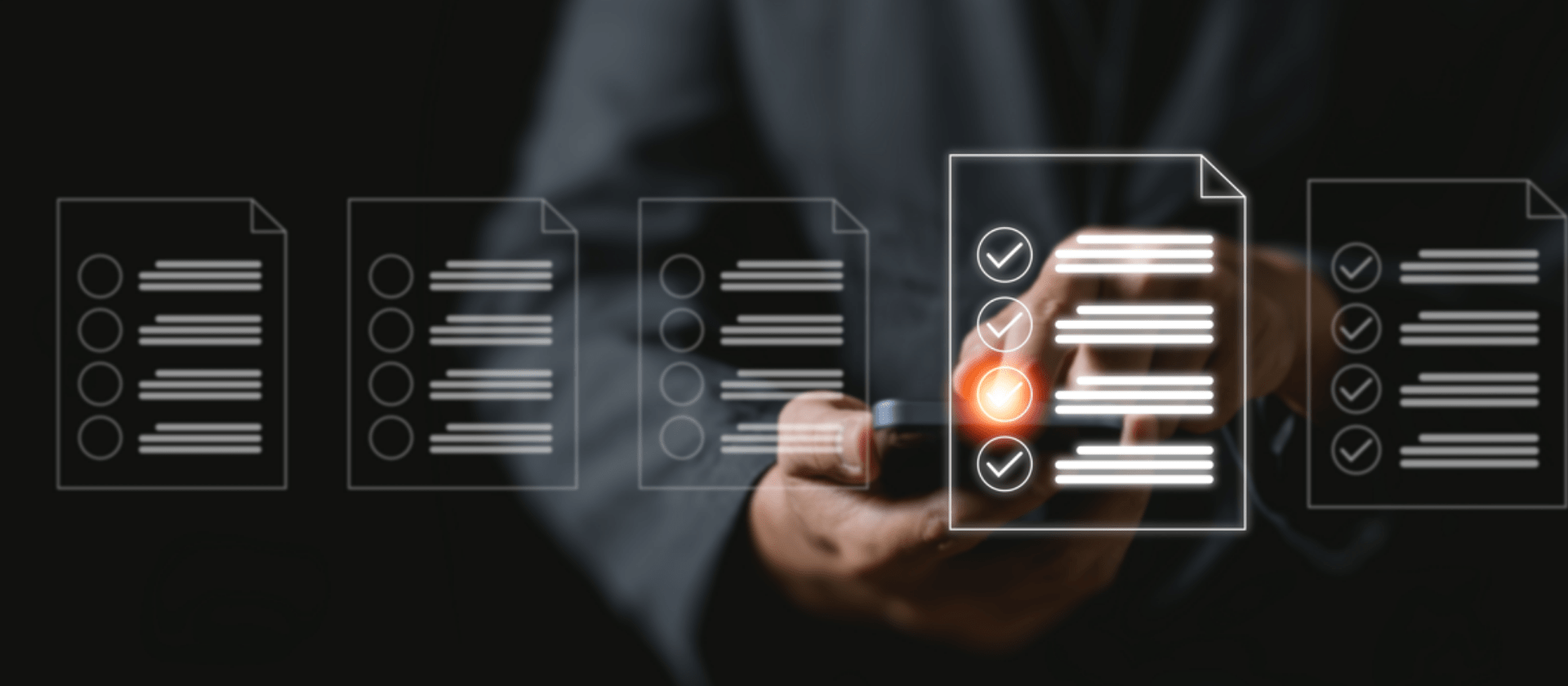pLG order management

Complete order management and planning solution
Optimized procurement channelsThe pLG order management system is a complete order management and planning solution that embeds all processes from order entry by sales channel to supplier invoicing control. The pLG order management system helps to optimize procurement channels, to reduce stock levels and to ensure cost control in the supply chain.
- Perfect synchronization between supply and procurement demand
- Implementation of customized solutions
- Improved procurement reliability and market responsiveness
- Inclusion of brand guidelines
- Optimized sales management
- Reliable and individual ordering
Functions
- Planning – Scheduling
- Logistics order management
- Replenishment planning
- Financial module
- Simulation and reporting
- Process automation
to the pLG order management system
More detailsThe functional scope of the pLG order management system ranges from supply chain planning to customer orders and procurement management.
Planning – Scheduling
Management of the procurement logistics system
- Description and configuration of logistics locations and associated product ranges, distribution channels (store, web, drive …)
- Definition of procurement strategies (Stocked Flow, Pulled Flow, Mixed Flow)
- Regional, national and international procurement
- Interfaces to the most important ERP systems on the market
Assortment and master data management
- Consideration of procurement and local products
- Management of logistics master data: product, price, supplier, store and other delivery points
- Several logistical handling units are managed per product reference (pallet, boxes/inside, piece)
- Consideration of product-specific characteristics: e.g., customs declarations for alcohol products subject to excise duty and management of hygiene restrictions for perishable products (best-before date, expiration date), load carriers for store deliveries (roll, pallet, etc.)
- Assortments managed per store (store capacities, marketing positioning, etc. taken into account)
Planning and ordering schedules
- Rules for the supply strategy by sales channel: STORE, web, drive-in
- Rules for upstream procurement by suppliers
- Smoothing rules for warehouses (capacity limits and flexibility limits)
- Saves smoothing rules
- Generation and transmission of assortment order plans (list of products available when ordering)
Logistics order management
Order entry by sales channel
- Validation and checking of orders, provided they match the historical orders, as well as checking the completeness of store responses
- Order integration via EDI or via a collaborative portal “OMS Web Point-of-Sale”
- Automatic generation of orders in the event of an anomaly
- Automatic notification if the ordered reference is not included in the order plan. Order consolidation by sales channel
- Order confirmation to the store back office
Order changes and urgent orders
- Management of order changes
- Change notification to the store back office: “Push Order” when the order and/or price is changed
- Specific management for orders not included in the order plan and in particular for the management of urgent orders
Purchase price and retail price calculation
- Purchase price construction: Supplier discounts and prices per packaging unit are taken into account throughout the entire process of generating supplier orders (availability, closure, etc.).
- Including eco-tax, specific VAT rates, purchase subsidies, etc.
- Calculation of logistics costs and determination of the store transfer price
Distribution of orders across multiple locations and multiple channels
- Optimized distribution of orders to the picking and shipping locations according to the logistics parameters (preferred location, warehouse stock, etc.)
- Division of the order quantities into several pickings according to the reference availability per location
- Management of transfers between locations
- Management of multiple WMS
- Management of multiple distribution channels: Distribution of orders to warehouses for store, drive and web requirements
- Exception handling: order postponement/rescheduling (quantity, quality problem/product, lead time)
- Management of store returns and supplier returns
Replenishment planning
Merging inventories
- Consolidation of stocks from the various warehouses
- Stock valuation per item and per warehouse
- Stock obsolescence analysis and product specifics (quarantine, best-before date, expiration date, etc.) and service restrictions (UBD + x days…)
Procurement calculation and generation of supplier orders
- Grouping of purchase orders and supplier orders according to the logistics flow organization; Pulled Flows: Generation of supplier orders based on net requirements (store orders); Inventory flow: generation of supplier based on inventory replenishment rules (consideration of remaining stock, etc.) according to an order proposal; Mixed Flow: part of the references in the inventory flow, part of the references in pulled flows (including the possibility that the references dynamically evolve into inventory and pulled flows)
- Management of all types of supplier orders: global orders for multiple stores; store orders packed by the supplier for cross-docking in the warehouse; store orders specifically compiled by the supplier to include variable weights and differentiated prices per store
- Procurement management of multiple locations and multiple suppliers: Managing multiple locations (national, regional and international inventory); managing multiple suppliers (multiple sourcing references, especially for “private” labels)
- Product-specific features: Management of hygiene restrictions pre-date, expiration date, batch release according to quality test results (positive release); Management of service restrictions: Shelf life UBD + x days; alcohol management; dangerous goods management; management of logistics handling units
- Product chain management in the event of substitution and/or end of life
Collaborative exchange of suppliers
- EDI integration for the transmission of supplier orders (purchase orders etc.) and supplier delivery bills (DESADV “shipping notification message”, global or in batches)
- EDI integration for the invoice flow – see finance module
- Collaborative web portal “Logistar OMS Web Supplier™”.
- Supports supplier-driven inventory solutions with manufacturers: sharing of inventory and integration of order proposals for the industry
Financial module
Purchase price and store transfer price calculation (see section Logistics order management)
- Purchase price construction: inclusion of supplier discounts and prices per packaging unit in the entire process of generating supplier orders (release, closure, etc.)
- Eco-tax, specific VAT rates, purchasing campaigns, etc.
- Calculation of logistics costs and determination of store transfer prices
Purchase invoices from suppliers
- Determination of the expected invoicing in connection with supplier purchases, based on the procurement orders carried out and after adjustment of the confirmed receipts
- Comparison with invoices received from suppliers via XML/EDI integration or manual input
- Automatic matching management including automatic search for discrepancies using detailed line analysis, creation of payment documents, anomaly management
- Creation of purchase logs
Store, web and drive sales invoices
- Creation of store invoices based on confirmed deliveries
- Creation of sales reports
Anomaly and adaptation management
- Management of errors and anomalies in connection with confirmed receipts and deliveries
- Generation of elements for associated accounting documents (credit note on sales invoice, expected credit note on purchase invoice)
Simulation and reporting
Purchase and sales analysis
- Purchase analysis
- Sales analysis
Service prices
- Service prices for suppliers
- Prices for branch procurement services
Process automation
Automation of tasks with low added value
- Automatic start of processes after completion of each key phase
Automatic / manual configuration
- Option to activate and/or deactivate the automatic linking of the various process steps
Progress monitoring and control
- Dashboard for tracking the most important process steps
- Control and tracking of warning messages
If required, additional pick-ups can be added to the tour and displayed in the tour monitoring. As soon as this happens, the driver receives all the relevant instructions and information directly.
The implementation of customized solutions
Flexible and adaptable, the pLG order management system is able to provide a supply chain management solution that is adapted to the behavior of different product families and different distribution channels. The system enables a pull-flow procurement strategy that ensures “zero stock” (stock flow, batch flow and mixed flow at the same location).


Improved procurement reliability and market responsiveness
As customer satisfaction is of crucial importance, the pLG order management system helps to improve service for customers. The system optimizes administrative costs and shelf space costs, improves the reliability of procurement thanks to planning and bottleneck management and guarantees better flexibility in the event of market changes.
The inclusion of brand guidelines
The pLG order management system manages product ranges in accordance with the company’s marketing policy. It is also able to manage the pricing policy and price grid of suppliers as well as advertising measures.
Logistar OMS manages product ranges in accordance with the company’s marketing policy. It is also able to manage the pricing policy and price grid of suppliers as well as advertising measures.


Optimized sales management
Thanks to the consolidation of multi-channel orders from the various sales channels, such as stores, Internet, drive-in, etc., the sales management process becomes more reliable, while at the same time the number of orders to be processed is reduced. Sales management is easier thanks to the web supplier optimization module, which enables orders to be entered directly via the Internet.
We will be happy to advise you on our products
We are here for you.Give us a call or send us a message. We look forward to welcoming you.
proLogistik Holding GmbH
Fallgatter 1
44369 Dortmund
Tel.: +49 (0) 231 5194-0
Tel.: +41 (0) 44 200 40-00
Tél.: +33 (0) 251 81 85 85
proLogistik Holding GmbH
Fallgatter 1
44369 Dortmund
Tel.: +49 (0) 231 5194-0
Tel.: +41 (0) 44 200 40-00
Tél.: +33 (0) 251 81 85 85
